Coin Values Moving with Precious Metals: Up-Dated 12/29/2025: Gold $4449 | Silver $75.46
Half Cent Values
All US half cents are scarce, in any condition. In context of US coinage; numbers of half cents minted throughout the entire series is small; 7,985,222 in total. These coins were a necessity to commence at the time, most circulated for years. Half cent values reflect rarity, condition and popularity as a collectible.
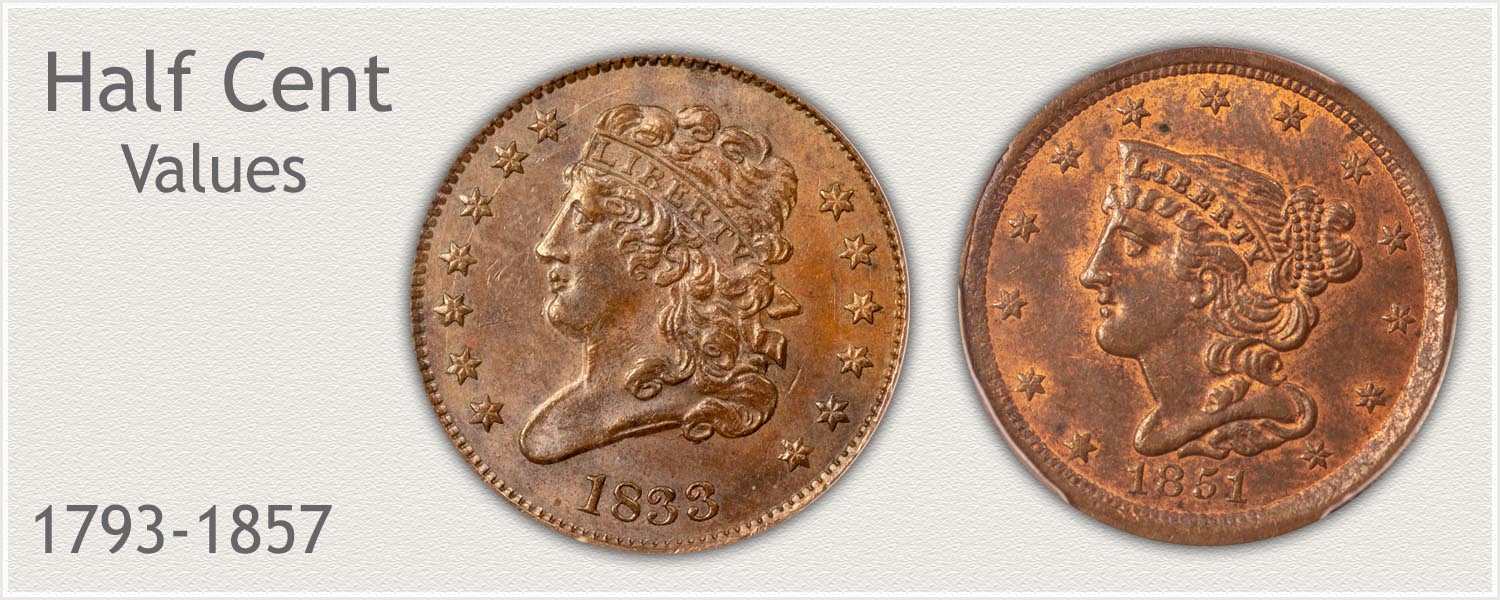
Steps Leading to Value:
- Step 1: Date and Variety - Accurately identify different varieties and dates spanning half cent series.
- Step 2: Grading Condition - Important elements are judged and condition is graded.
- Step 3: Special Qualities - These old pennies are copper and many factors contribute to value.
Preview the value table and then follow the steps outlined to determine how much your half cents are worth.
| Half Cent Values 1793-1857 | ||||
|---|---|---|---|---|
| Condition of Coin | ||||
| Date | Good | Fine | Extremely Fine | Mint State |
| Half Cent Values Up-Dated | 2026 | |||
| Liberty Capped Variety 1793-1797 | ||||
| 1793 | $2,040 | $5,350 | $12,375 | RARE |
| 1794 | $676 | $1,575 | $3,720 | RARE |
| 1795 | $550 | $1,470 | $3,585 | RARE |
| 1796 | RARE | RARE | RARE | RARE |
| 1797 | $471 | $1,095 | $3,325 | RARE |
| Draped Bust Variety 1800-1808 | ||||
| 1800 | $113 | $166 | $456 | $2,880 |
| 1802 | $749 | $2,940 | RARE | RARE |
| 1803 | $99 | $172 | $711 | RARE |
| 1804 | $87 | $135 | $305 | $1,775 |
| 1805 | $100 | $174 | $420 | $2,070 |
| 1806 | $85 | $151 | $294 | $1,520 |
| 1807 | $93 | $121 | $339 | $1,748 |
| 1808 | $99 | $178 | $452 | $3,135 |
| Classic Head Variety 1809-1835 | ||||
| 1809 | $67 | $77 | $170 | $729 |
| 1810 | $62 | $105 | $623 | $1,699 |
| 1811 | $370 | $657 | $2,393 | RARE |
| 1825 | $60 | $76 | $175 | $645 |
| 1826 | $60 | $76 | $110 | $453 |
| 1828 | $57 | $67 | $126 | $348 |
| 1829 | $57 | $87 | $142 | $411 |
| 1831 | RARE | RARE | RARE | RARE |
| 1832 | $53 | $70 | $114 | $244 |
| 1833 | $54 | $77 | $126 | $380 |
| 1834 | $58 | $82 | $114 | $218 |
| 1835 | $53 | $78 | $106 | $222 |
| Braided Hair Variety 1849-1857 | ||||
| 1849 | $47 | $60 | $173 | $514 |
| 1850 | $77 | $108 | $418 | $1,050 |
| 1851 | $36 | $56 | $104 | $192 |
| 1853 | $42 | $56 | $165 | $201 |
| 1854 | $47 | $56 | $200 | $239 |
| 1855 | $42 | $51 | $167 | $182 |
| 1856 | $47 | $56 | $176 | $234 |
| 1857 | $53 | $76 | $173 | $353 |
Above are wholesale coin values. Computed from dealer's price lists and rare coin auctions with various mark-up factors figured in. They reflect closely the value you would expect to receive when selling. Variations in value do occur subject to subtle grading points, collector demands and dealer needs.
Step 1: | Date and Variety Attribution
Four major varieties of half cents were issued. Each variety is valued separately and have their unique characteristics. Date of the coin helps in determining variety along with a close examination of the design elements.
1793 to 1797 Liberty Capped Variety
1793 - production begins of Half Cent at the newly established US Mint. In the first year only 1793; Liberty faces left and the domination of Half | Cent is within a wreath on the reverse. From 1794 to 1797 Liberty faces right with the reverse remaining similar. Approximately 365,000 of this variety were minted with few surviving today. Most encountered are worn heavily, a statement to the needs of a national coinage.
1800 to 1808 Draped Bust Variety
A redesigned portrait of Liberty with date underneath is the design of the obverse. Reverse is an olive wreath; in bold is Half | Cent within wreath. Fraction 1 over 200 if found below wreath. Scarcity continues with total mintage of variety just under 3,500,000 pieces.
The Draped Bust variety is popular with collectors with a strong demand. Most surviving 1800 to 1808 half cents are heavily worn. Nice condition, lightly worn examples are eagerly sought.
1809 to 1836 Classic Head Variety
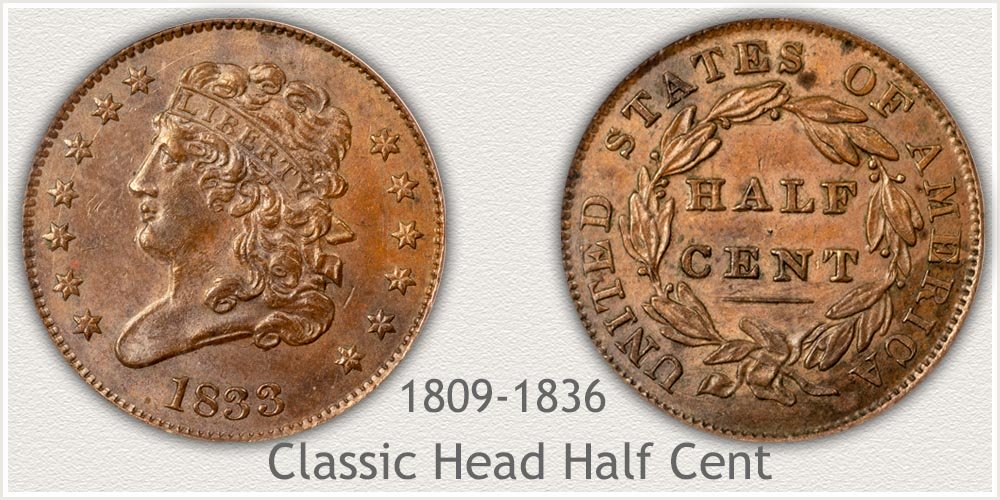
A complete redesign of Liberty's portrait is presented with her now facing left. A head band featuring "Liberty" inscribed creates a strong presentation. Reverse is a laurel branch encircling Half Cent. Collectors have a slightly greater supply of this variety to choose from. Classic head half cents are an affordable old US coinage.
1840 to 1857 Braided Hair Variety
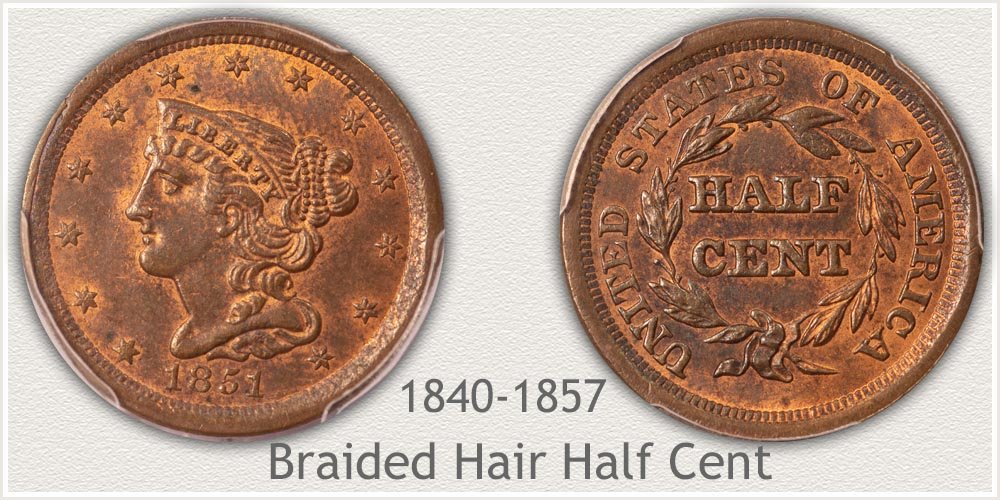
1840's saw a new design of Liberty on half cents. Small quantities of special "Proof" examples were coined 1840 to 1849. Coinage struck for circulation began in 1849 and in 1857 the last half cents were struck ending the series.
Liberty is redesigned featuring a coronet inscribed with "Liberty" and her hair tied with a double row of beads. Reverse is a slightly modified laurel branch from prior years with Half Cent within. Mintage of circulating issues is 544,510 pieces. Although a small output in total numbers; the half cent denomination was used less in commerce by this time allowing them to survive until today. Availability adds to their popularity and value.
Step 2: | Condition is Judged and Grade Determined
Condition is a key factor in determining half cent values. Collectors are always looking for coins with the least amount of wear. The better the state of preservation of your coin, the higher the value... sometimes much higher.
The concept is straight forward, as a coin circulates and wears, all the varying degrees of its condition are each assigned a "grade".
Compare your coin to the grading images and find the closest match. If your coin is slightly better than pictured, use the higher value of the price range.
Grading Condition of Classic Head Half Cents
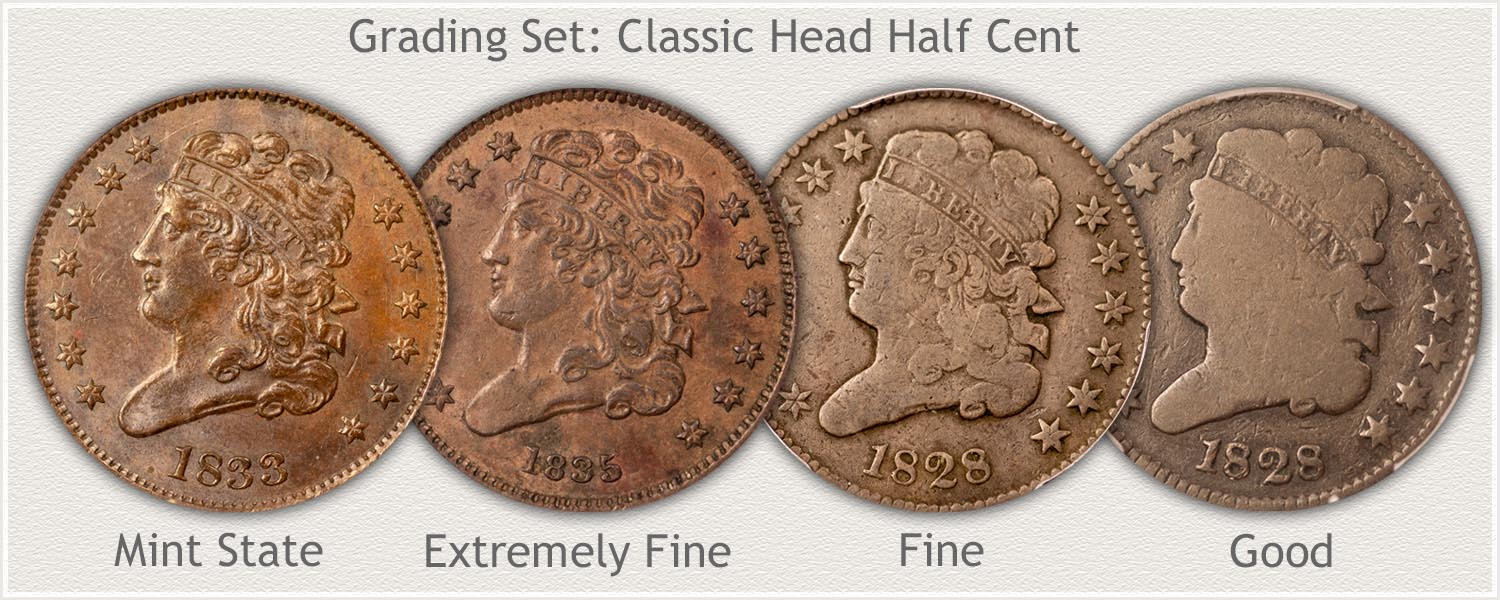
Mint State Grade: Classic Head Half Cent
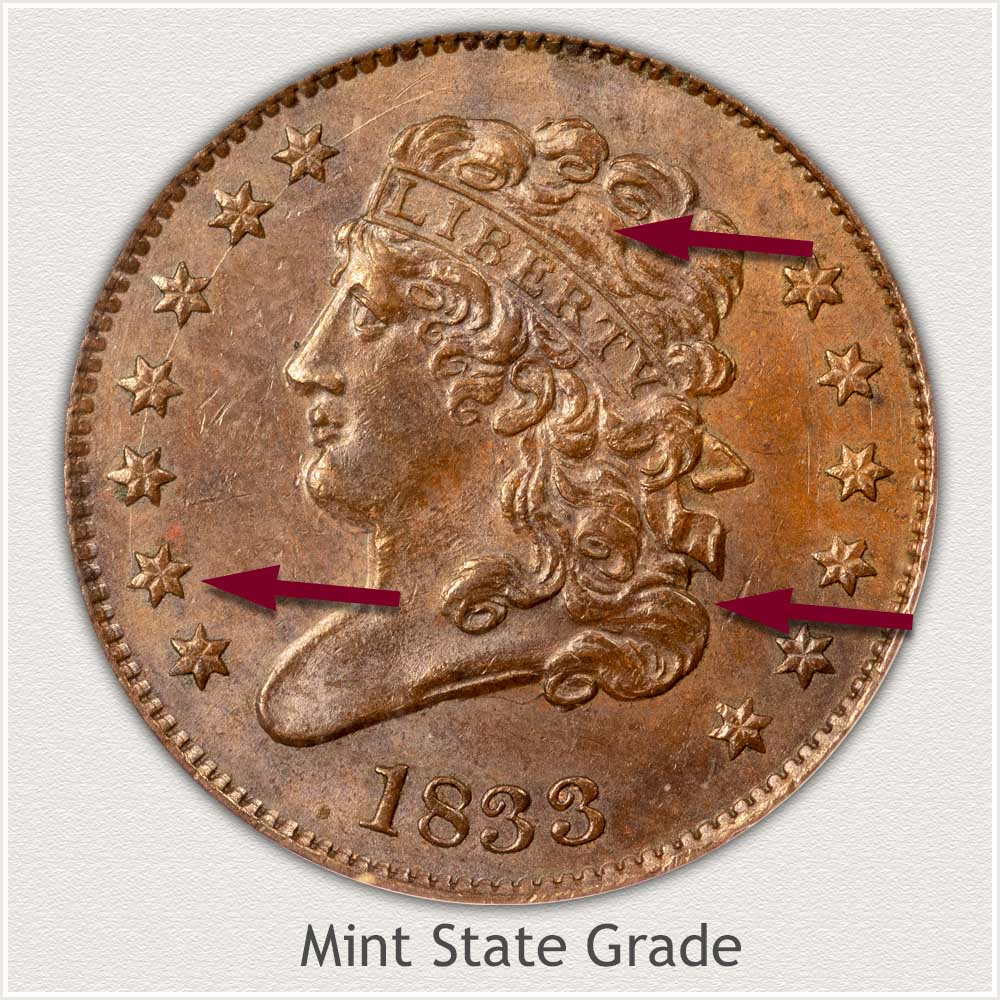
Obverse: Separating a half cent in Mint State grade from a circulated coin is absence of wear to any part of the design. Metal surfaces are as minted.
Inspect Liberty's hair above the ribbon. Waves of hair are deeply separated and tops of curls are rounded. A texture to the metal remains in these high points without any significant smoothing.
Scan all stars. Each needs to remain without any flattening to the centers and ridges forming the points. Of note: variances in depth of striking occurs. Inspecting all of the stars gives a clear indication of the differences between wear on top of the star or flatness due to a weak strike.
Tilt the coin under a single light source. Viewing areas of hair at the back of Liberty's neck; roundness to strands remains on a mint state example.
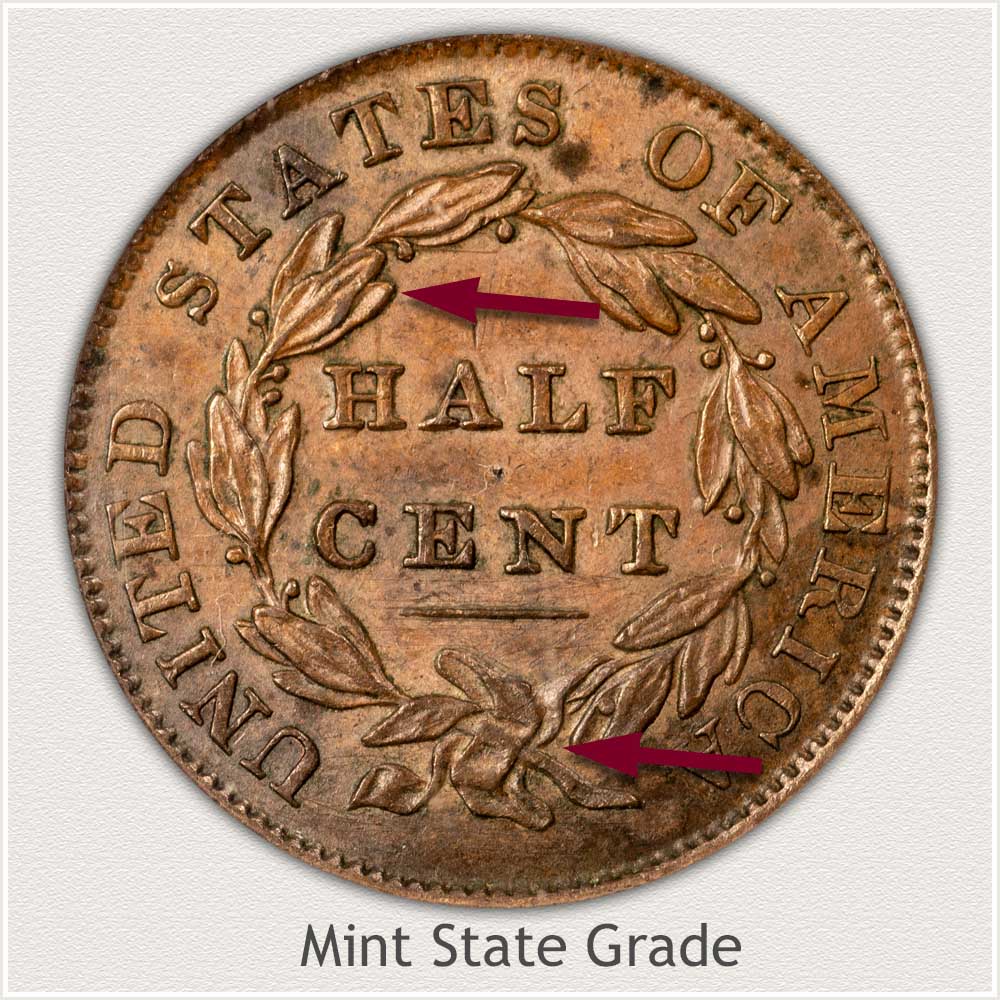
Reverse: Inspect the leaves surrounding Half Cent. Most leaves have a raised edge with a raised line within the center. Wear would show as a smooth and flat area on leaf edges. Confirm a profile remains without smoothing.
A ribbon is featured at the lower end of wreath. Raised areas are visible without any smoothing to the metal.
Extremely Fine Grade: Classic Head Half Cent
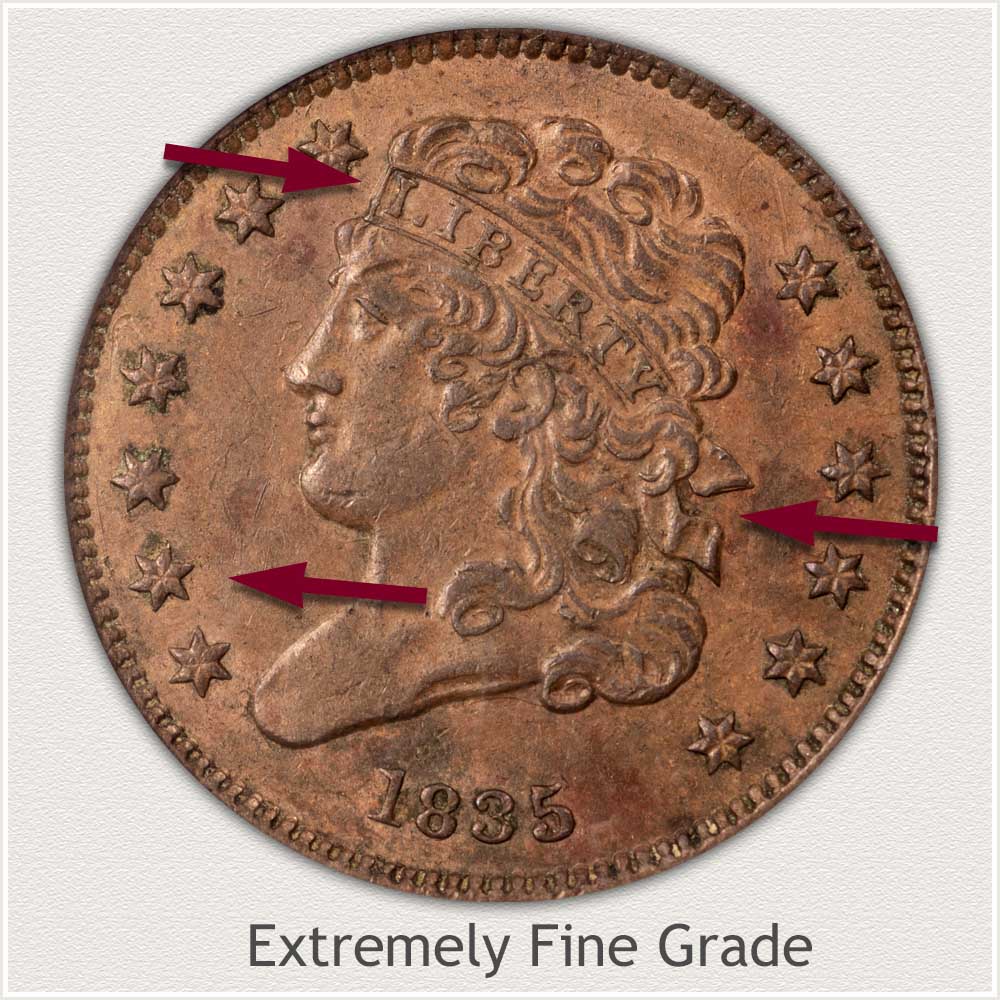
Obverse: A small amount of wear is beginning to show over the surfaces of an Extremely Fine grade half cent. Portrait of Liberty remains crisp and sharp. Adding to the boldness of Miss Liberty is all major strands of hair are separated and well defined.
Inspecting above the eyebrow and ribbon finds a small amount of flattening to the crests of the hair curls. Confirm all strands are clear with no merging.
Looking closely at the centers of the stars; most show a separation of the points continuing to the centers. A small amount of smoothing is evident.
Ends of the "Liberty" ribbon are well defined with high and low relief details intact.
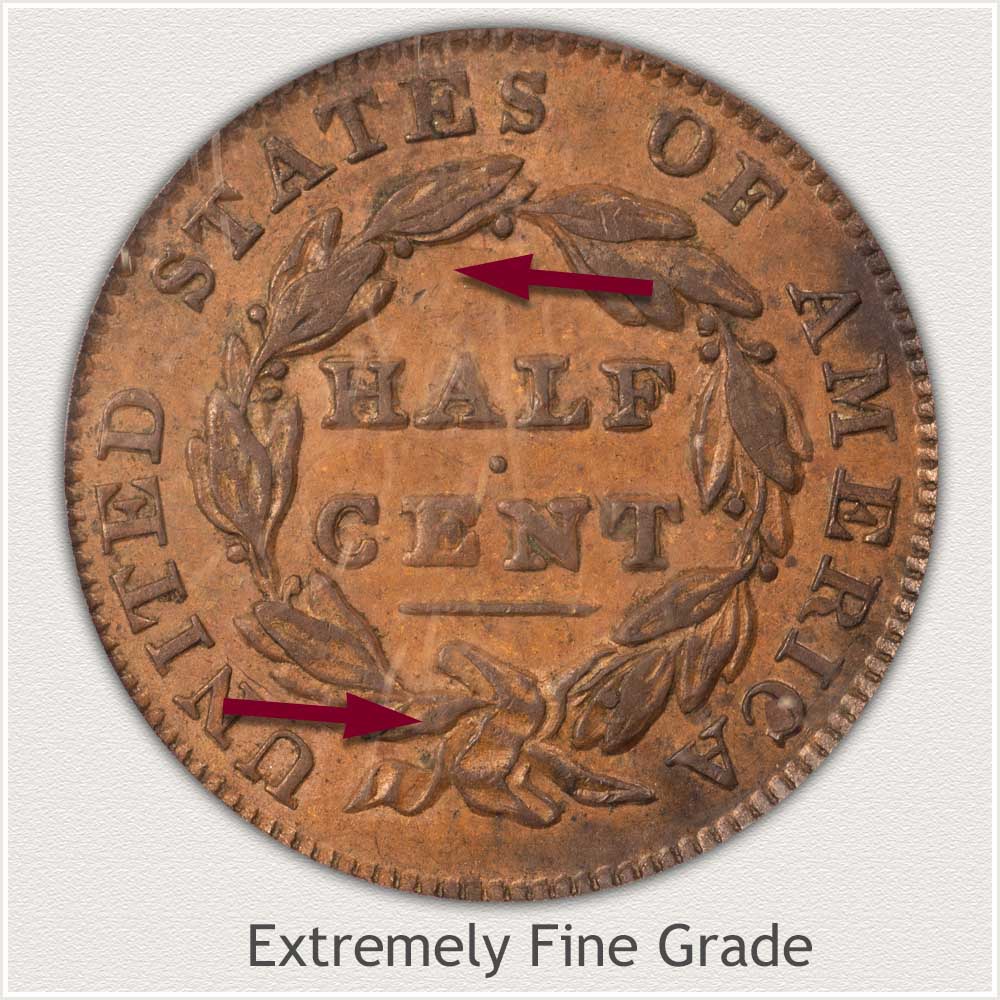
Reverse: A very distant laurel branch remains bold. Each leaf cluster is defined and leaves are clearly separated.
Center areas of leaves have lost detail on a few. Edges of all leaves are well separated and most retain a raised edge.
Lower ribbon is defined, curls evident and edges are raised. A small amount of wear has flattened upper curves to the waves in the ribbon.
Fine Grade: Classic Head Half Cent
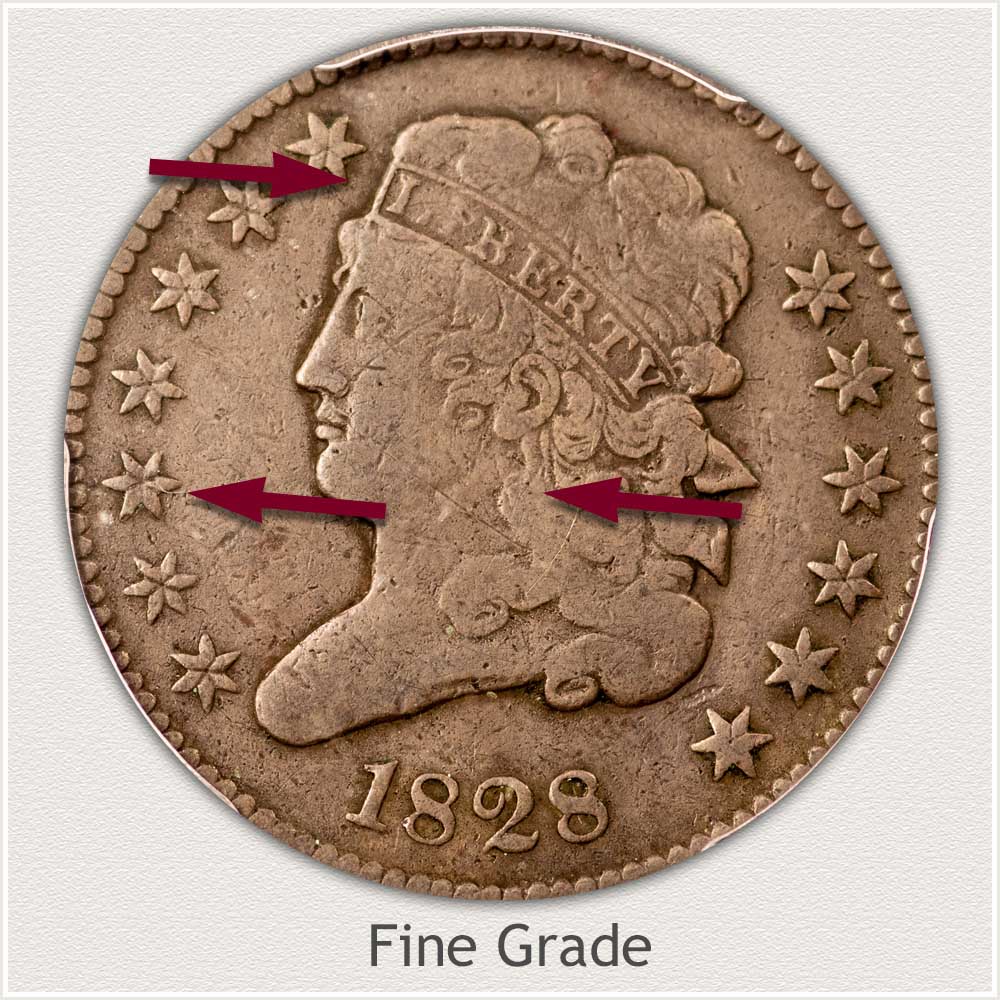
Obverse: Wear is now very evident to the entire surface of a Fine grade half cent. Condition is described as moderate wear.
Both above and below Liberty's hair ribbon is a concentration of wear and smoothing to the metal. This is a high point to the relief of the coin and many of the strands of hair are merged. Enough detail remains separating major curls and strands of hair placing the coin sold in the Fine grade. Note: Liberty's hair merges with neck in a few places and not continuous.
Stars are flattened with traces of central lines.
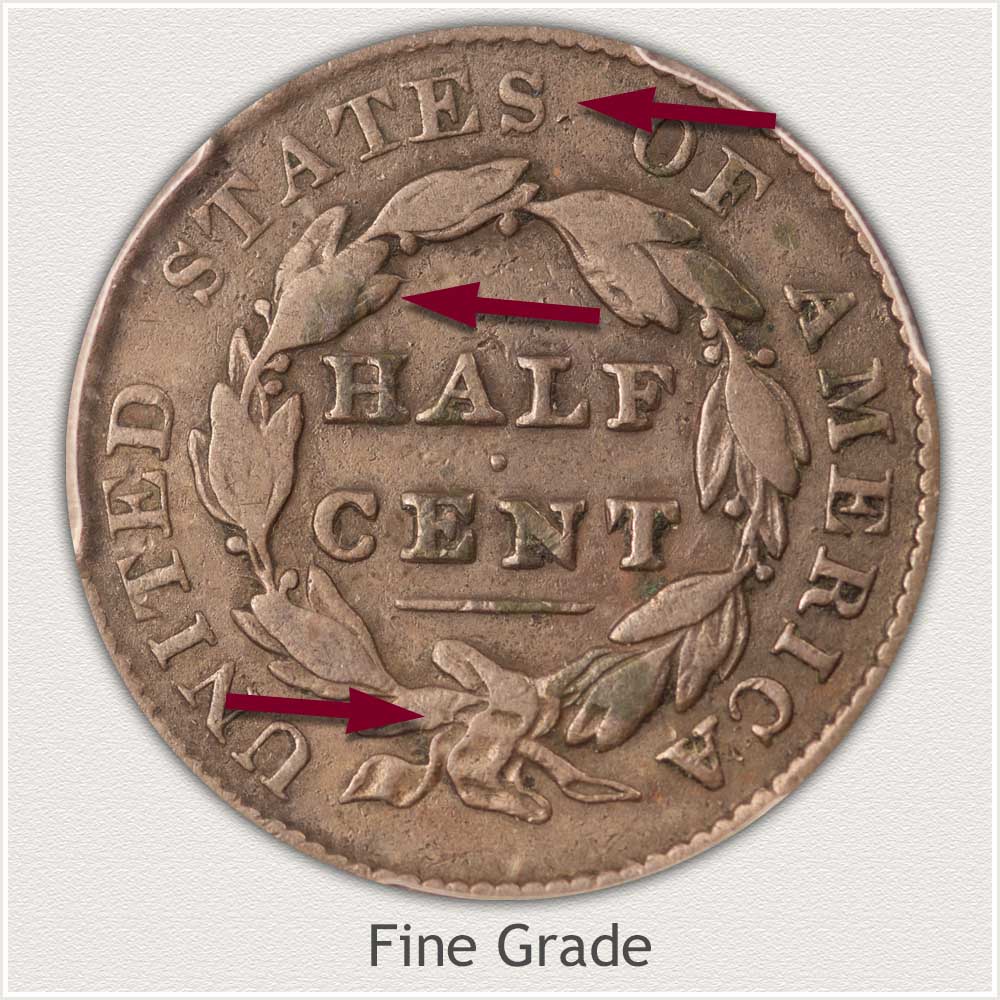
Reverse: Center details are now flat on uppermost leaves of each cluster.
Only in a few places have edges of leaves merged together to form a flat surface.
Ribbon is showing areas of flatness; however, edges are clear, and waves in the ribbon are well defined. All lettering is very bold.
Good Grade: Classic Head Half Cent
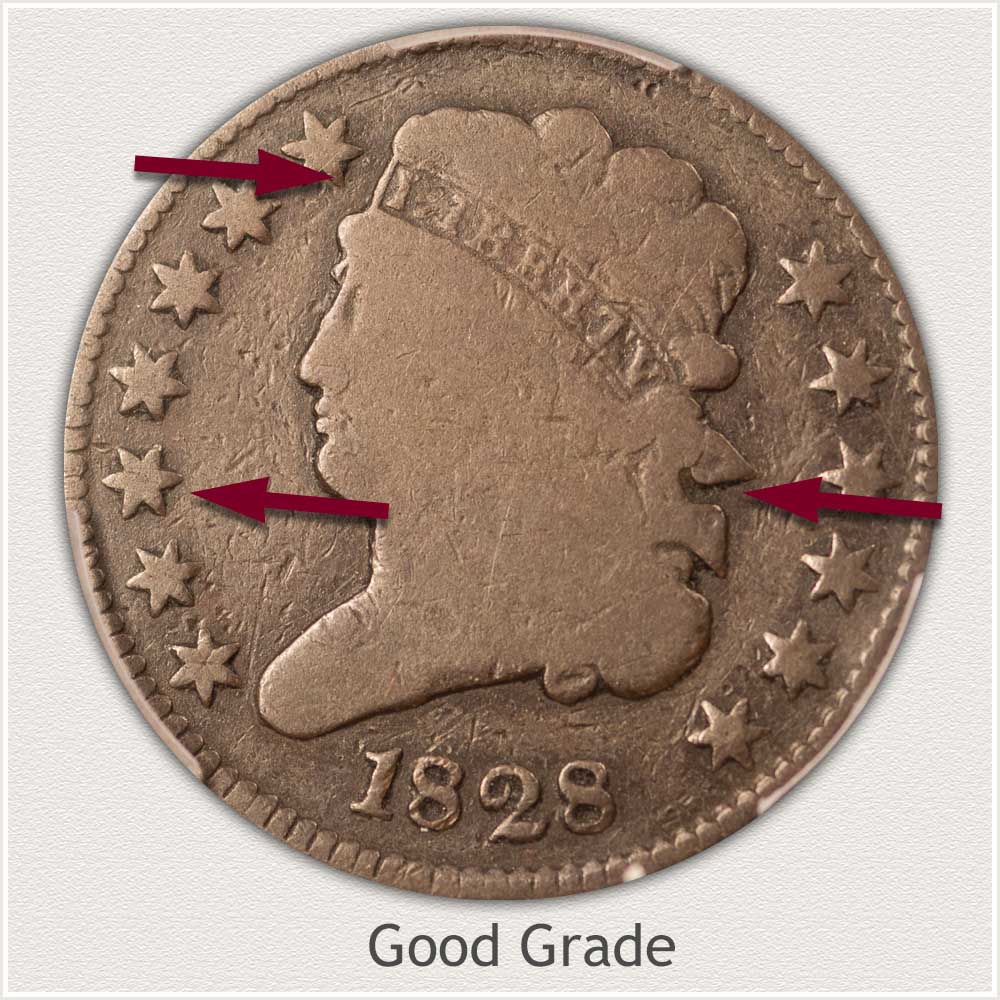
Obverse: Heavy wear describes a half cent in Good grade. A full date is readable and Liberty's portrait, mostly an outline, is raised above the field.
Hair strands are now missing from above and below the hair ribbon. Liberty's forehead is flattened with no hair detail. Lettering of "Liberty" on the head band is readable but often very weak.
Suggestions of ribbon and hair remain towards the back of Liberty's head and neck.
Stars are flat with no central detail. Rim is often weak in areas.
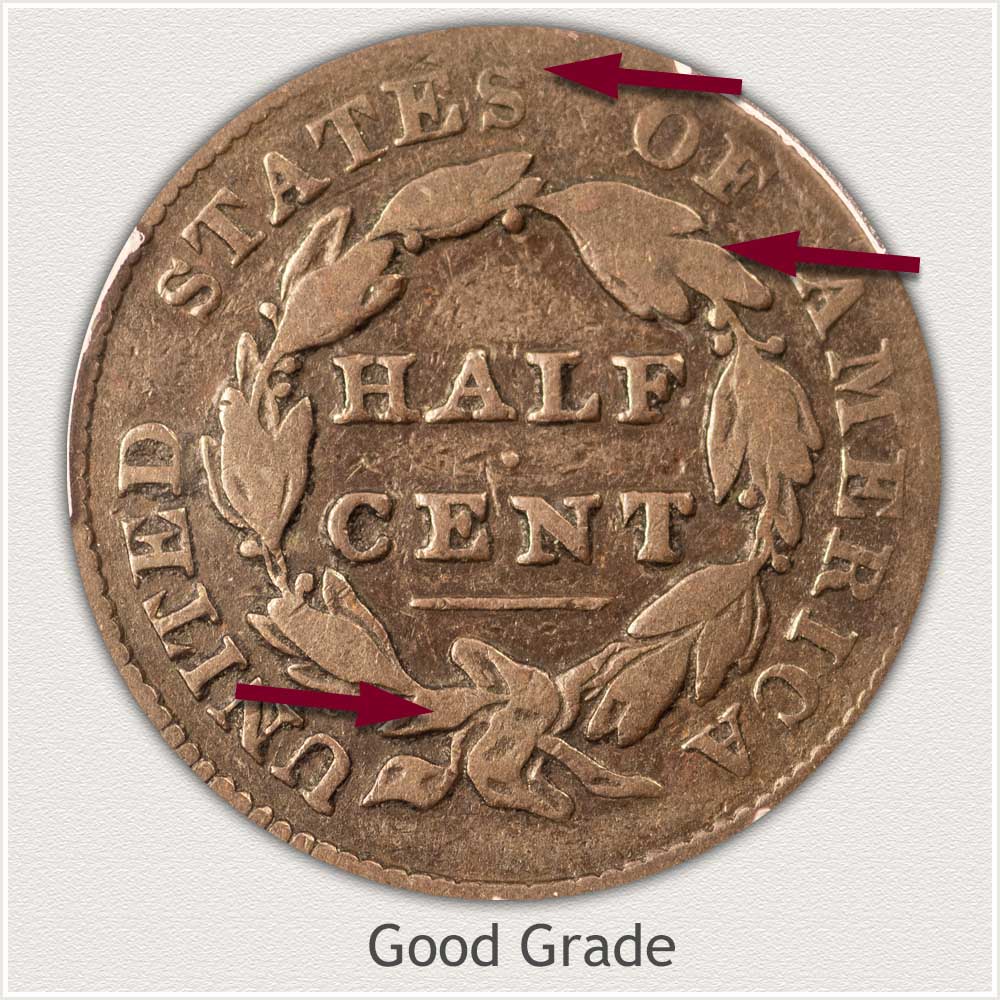
Reverse: Leaves defining the laurel stem are now merged forming groups, little to no separation remains. Each group of leaves are well defined.
Lettering of the legend is weak in areas with tops merging with rim. All lettering must remain readable.
Some detail remains to the ribbon at the base of the wreath.
Grading Condition of Braided Hair Half Cents
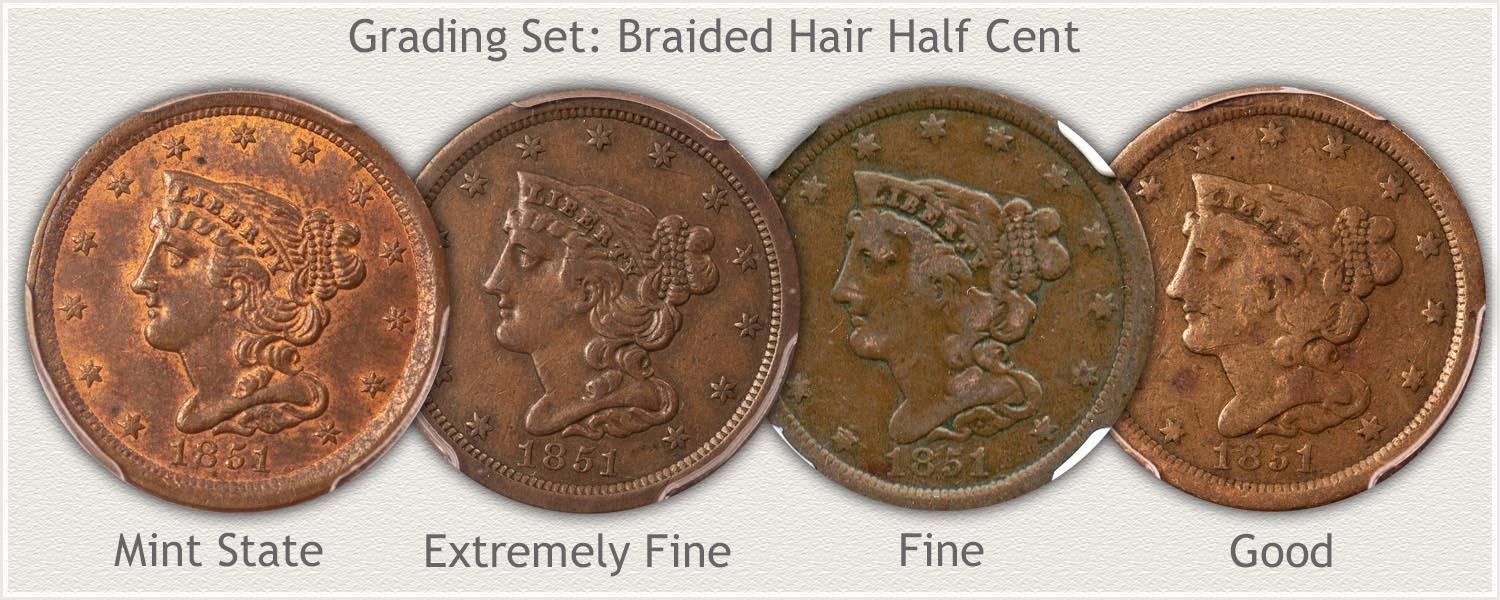
Uncirculated Grade: Braided Hair Half Cent
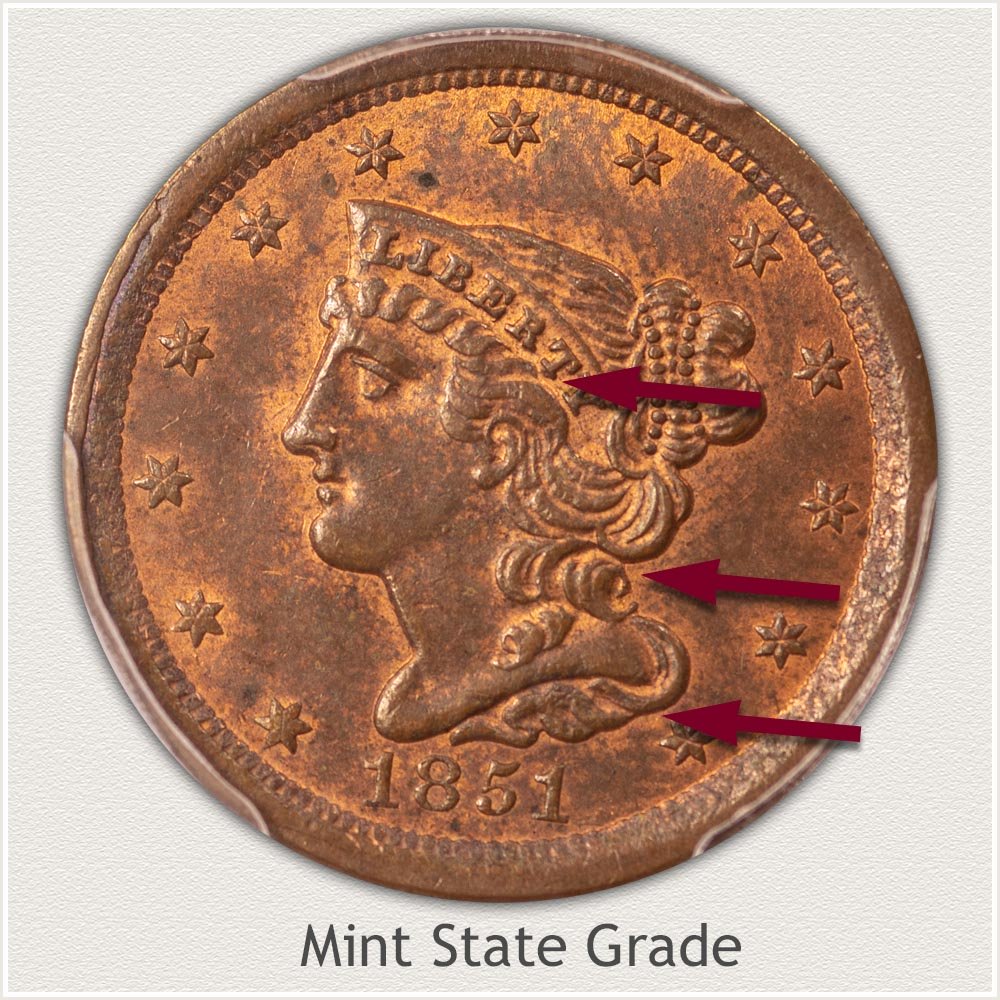
Obverse: A coveted grade by collectors, uncirculated - mint state half cents must remain without any wear to the surface. It is this important feature - no wear - that places these coins in the top grade.
A high relief area and first to inspect is the waves of hair just above Liberty's ear. Each wave remains rounded in profile. Wear would present as a smoothing to the surface and a change in color to the metal.
A second area are the waves of hair below the portrait. No smoothing indicates a lack of wear.
Laying on Liberty's shoulder are curls forming high areas. Each remains defined with roundness to all upper edges.
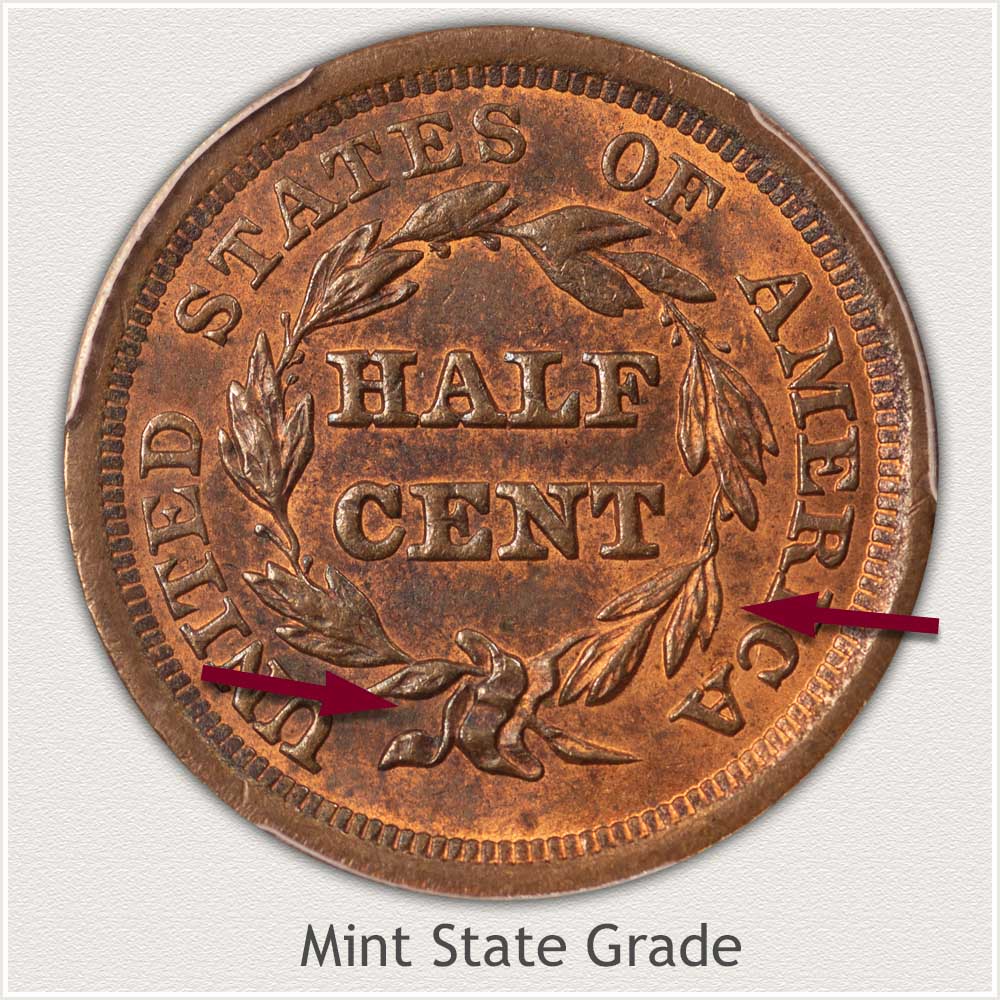
Reverse: A laurel branch surrounds Half Cent in the center. Each leaf of the branch is detailed with high and low areas and central lines. High ridges of the leaves are intact with no smoothing.
At the bottom of the wreath is a ribbon creating a connection. Waves of the ribbon are high in relief with no evidence of smoothing. Inspect also edges of the ribbon for any flatness caused by wear.
Extremely Fine Grade: Braided Hair Half Cent
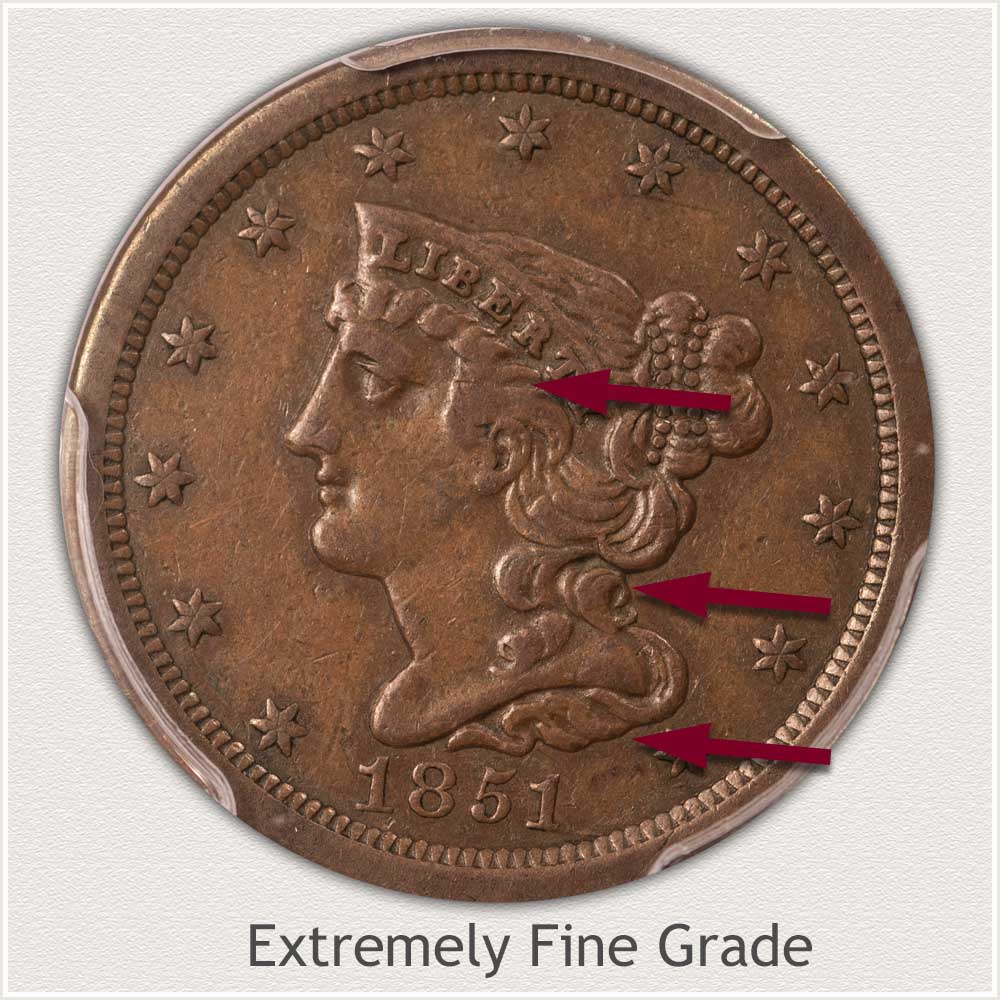
Obverse: Wear is just beginning to show on upper areas of the metal. Important to the Extremely Fine grade is very few areas of the design have merged.
Hair just above Liberty's ear displays a small flatness, slightly merging into one smooth wave. Ear remains separated from surrounding hair.
Below the portrait all waves of hair are separated and only a small flattening is evident on highest reliefs.
Curls of hair laying on Liberty's shoulder remain well defined. Smoothing is showing but limited to the central area. Separation of each curl remains.
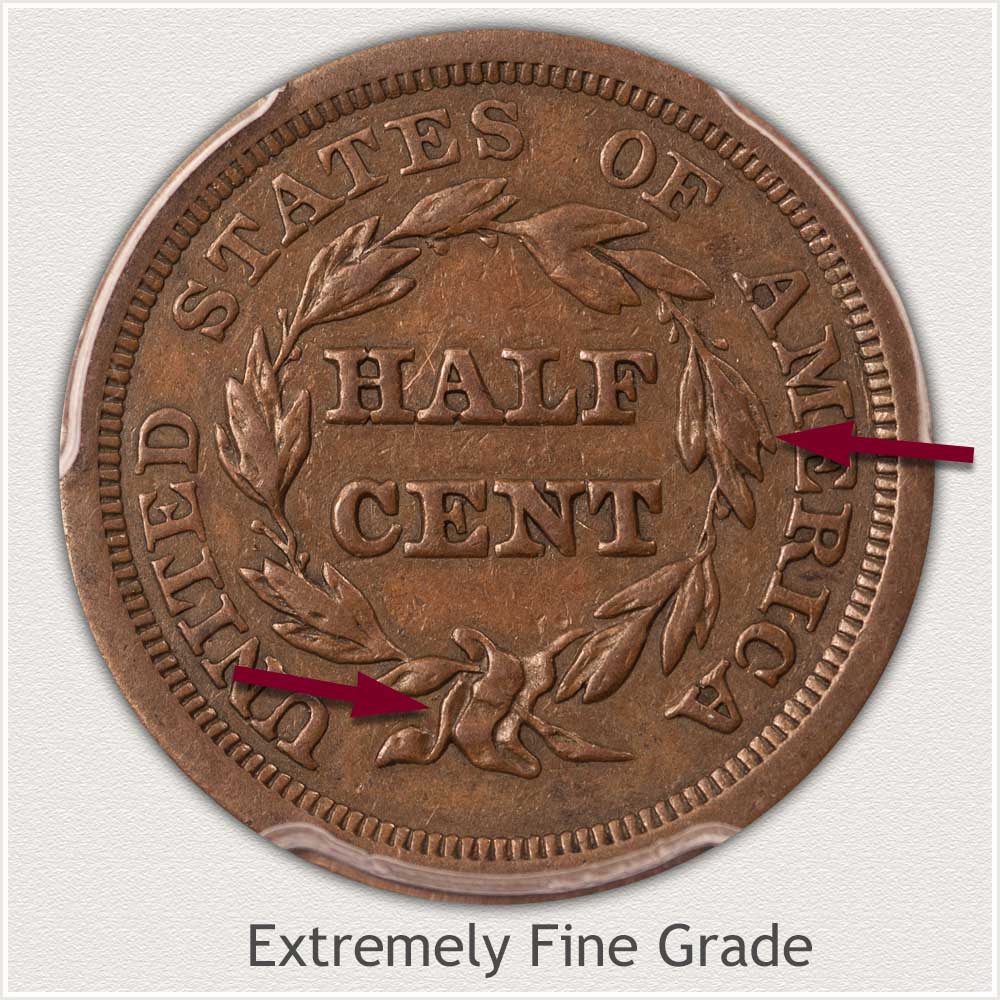
Reverse: Moderate wear has begun to flatten and remove central detail to the leaves.
Areas of smoothness are visible on center areas of a few leaves. Many leaves are well defined. Important is no merging and each leaf remains defined.
Ribbon at the connection of the laurel branch is distinct. Each wave of the ribbon is raised above any parts of the stem and leaves. A few small flat areas are noted on the upper curls of the ribbon. A prominent ribbon solidifies an extremely fine grade.
Fine Grade: Braided Hair Half Cent
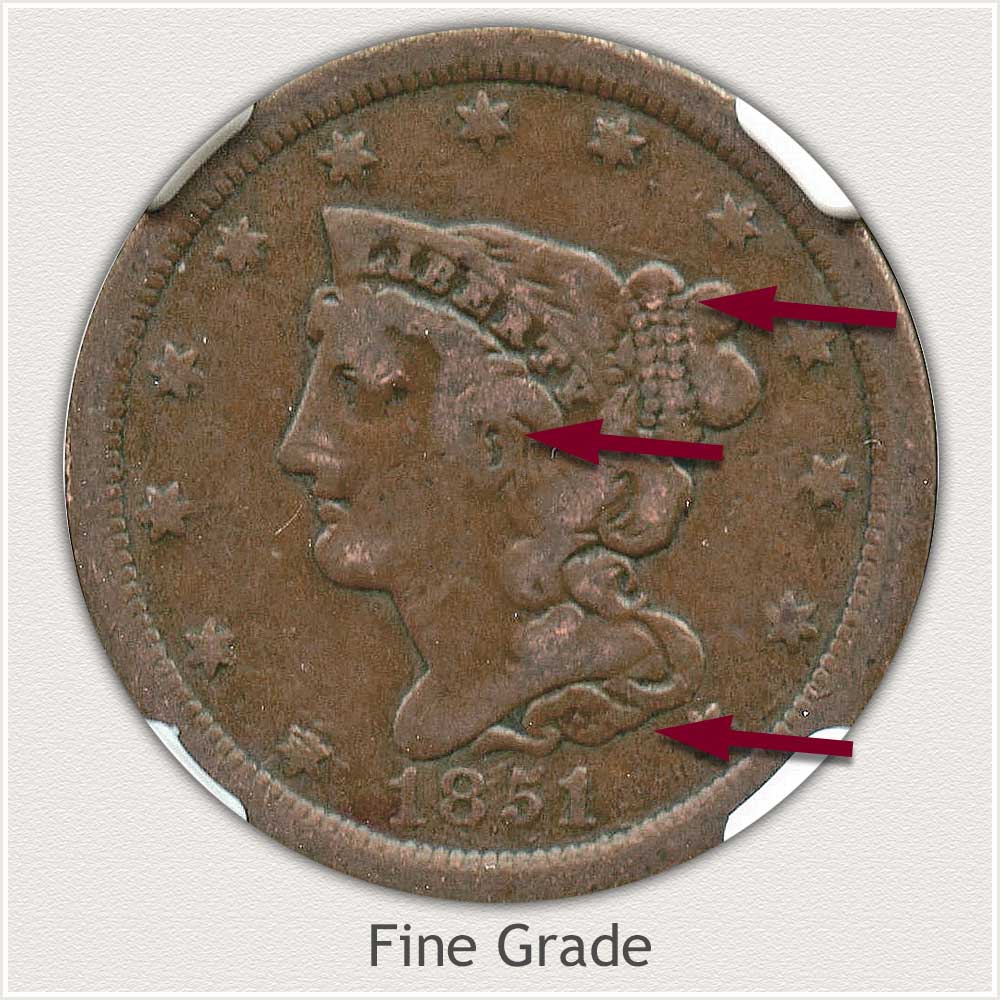
Obverse: A moderate amount of wear defines half cents in Fine Grade. Smaller details such as fine lines separating hair strands are beginning to merge.
Hair details above Liberty's ear are now one flat area and connected with hair braids of forehead. A slight definition separating her cheek from hair is visible in a Fine grade coin.
Below the portrait and just above the date, curls of hair are still strong, however, finer strands are no longer visible.
Placing this coin solid in Fine condition is strong details of the beaded cords tying Liberty hair. Distinct two rows of beads are fully separated and complete across the center.
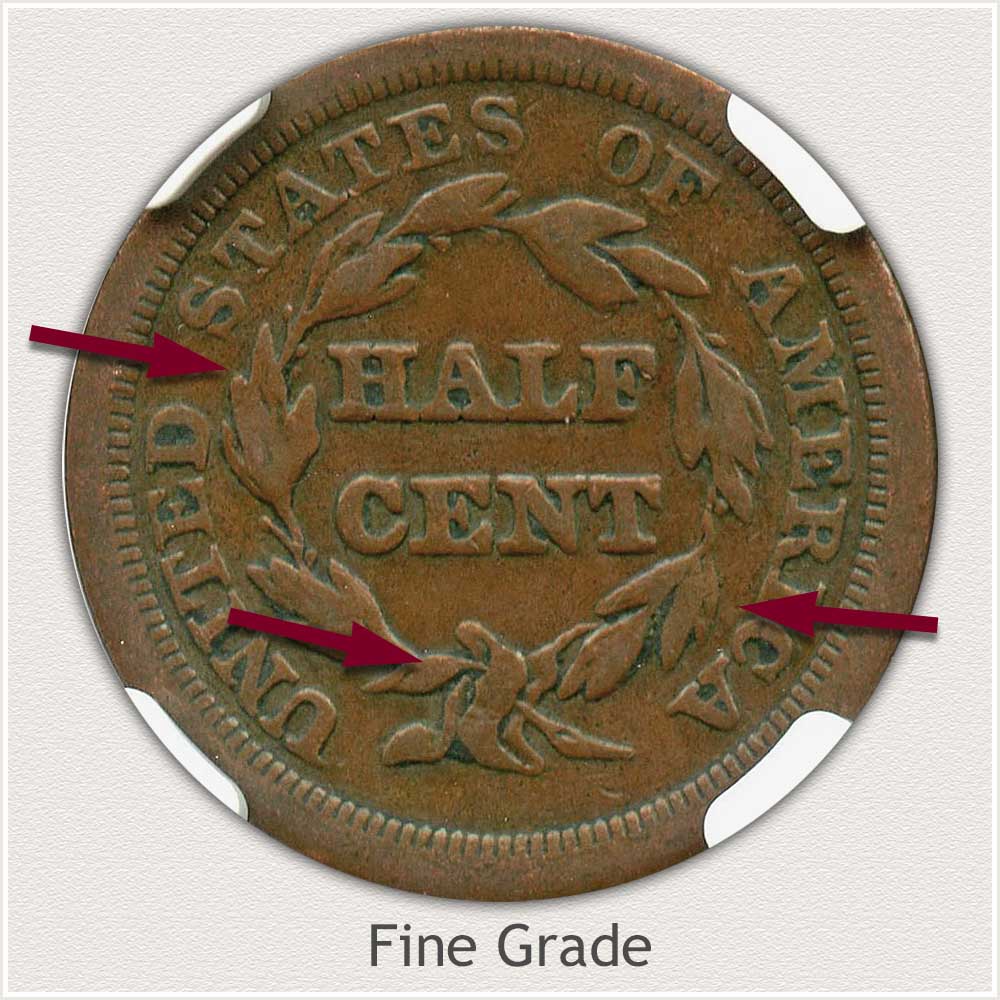
Reverse: Moderate amounts of wear has removed many finer details to leaves of the wreath. Many "top" leaves are completely smooth.
Raised edges of leaves are now smooth on upper leaves with lower leaves still showing raised edge detail. Separation defining each leaf is an important point to the fine grade. Inspect closely leaves adjacent to "H" of Half Cent.
Strong ribbon detail draped over the laurel stem gives definition to the overall pleasing look. Areas of the upper and under ribbon are clearly defined. Spots of flatness to the ribbon are evident but do not connect.
Good Grade: Braided Hair Half Cent
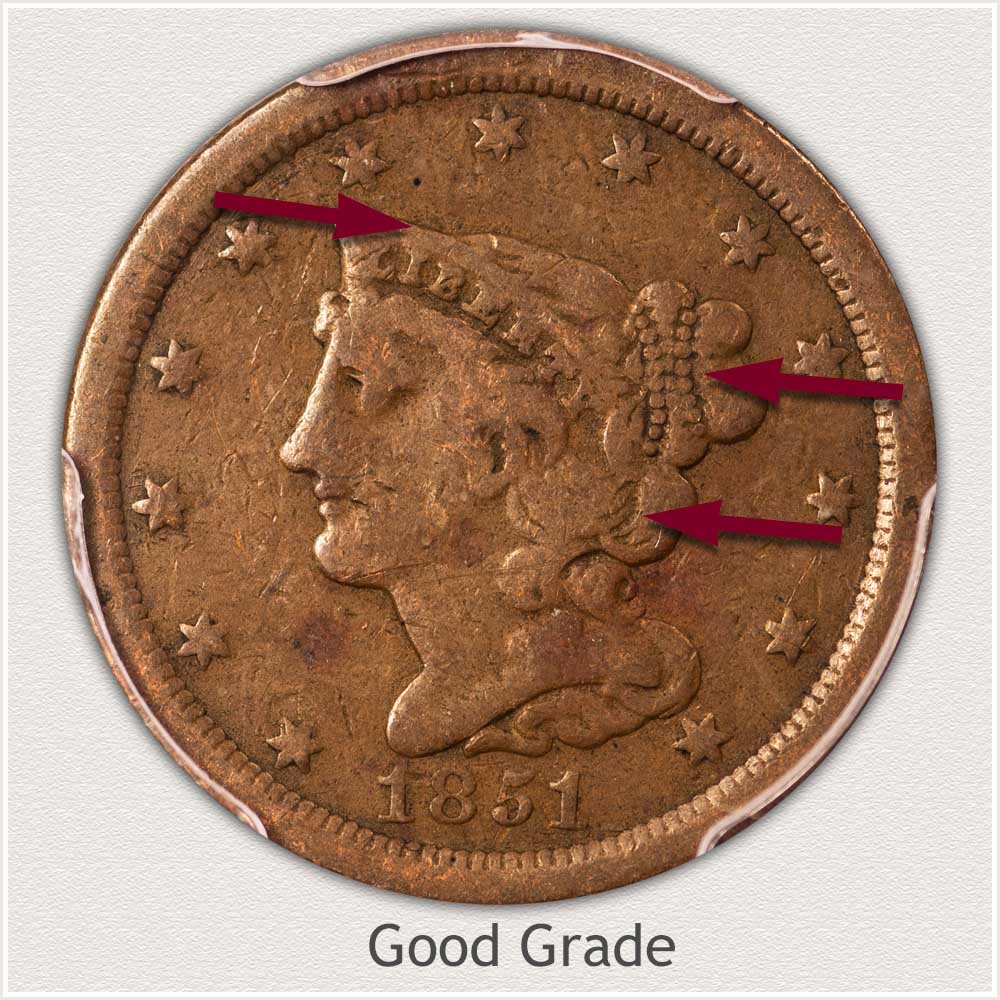
Obverse: Heavy wear is covering entire portrait of Liberty, defining the Good grade.
Hair is worn smooth lacking any fine strands. Towards the back, large curls remain slightly defined. Most hair detail has merged with Liberty's face and is now a flat plane.
A once a bold coronet is now blended with hair, however lettering of "Liberty" is readable.
Note: Evidence of a beaded cord tying Liberty's hair remains, adding appeal to overall look.
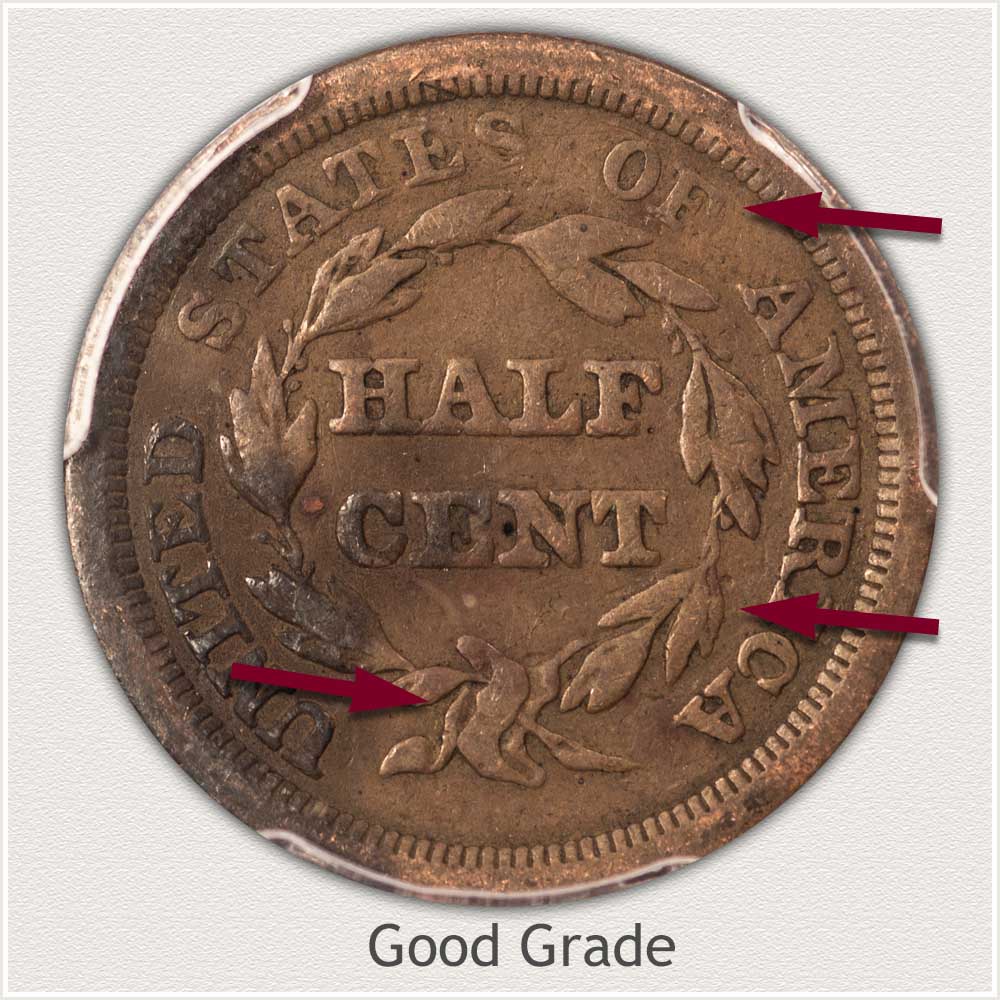
Reverse: Inspecting the leaves, most individual leaves have merged forming well-worn groups. Very few lines of separation define any single leaf.
Ribbon connecting the lower wreath is worn smooth, however, the center ribbon is clearly defined.
Lettering of the legend is readable with only minor fading. A nice appearance adds to a solid Good grade.
Professional Grading of High Value Half Cents
After comparing your coin to grading images you realize it is in very high condition, perhaps mint state. If identified as only slightly worn or better a small degree of difference has a big impact on half cent values.
High value - $100 and above examples are best sent to a grading service. Once certified their market acceptance at a grade is greatly improved.
Collectors and dealers consider PCGS and NGC as leaders in coin grading services. They both authenticate and grade your coin. The small fee you pay provides assurance you understand and receive the full value of your coin.
It is also helpful to know grading a coin is not an exact science. It is your opinion, dealers and collectors have their own opinions... and they can all differ slightly.
Step 3: | Special Qualities Recognizing Solid Value
Your old half cent has survived in a recognizable condition; date, variety, and condition are judged. Aesthetics now determines and separates top end coins. A worn coin is often pleasing because of mark free surfaces and nice color.
Three main qualities help separate these old coins apart from one other.
A special coin has avoided; damage, corrosion to its surface, and remains a pleasing color. Identify the presence or absence of these qualities helping solidify an understanding of value. Collectors appreciate aesthetic traits and positive eye appeal; and is often a deciding factor when adding a coin to a collection.
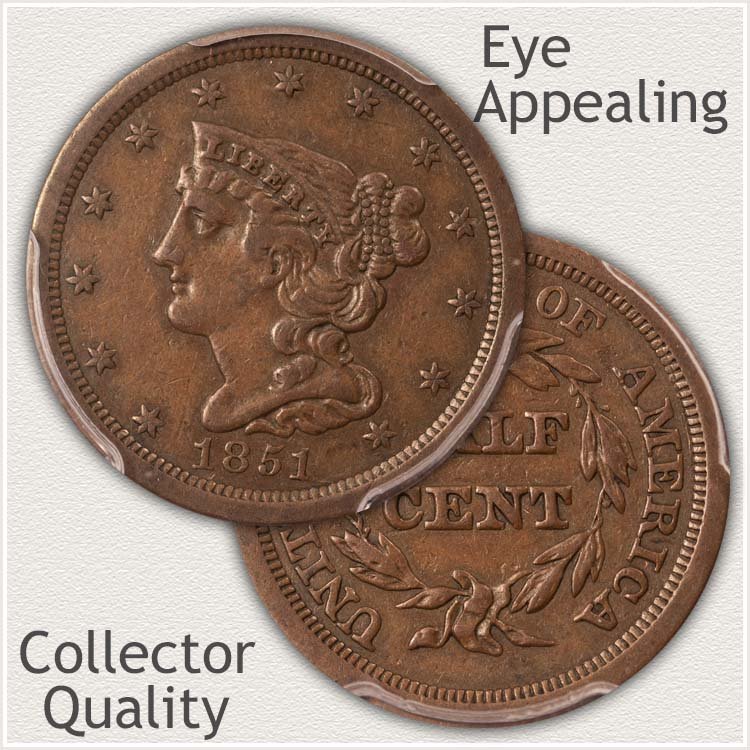
First example is a lightly circulated 1851 half cent. This coin exhibits a pleasing even color highlighting the design elements. Additionally, no marks or damage catch the eye. A desirable collector quality example.
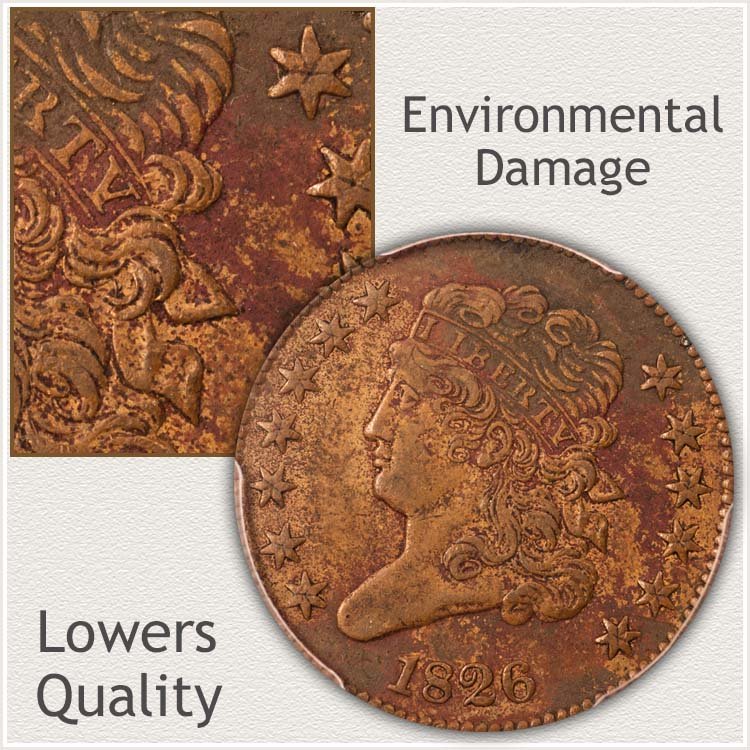
An 1826 half cent displays environmental damage. A discoloration is causing an unnatural appearance to the copper surface.
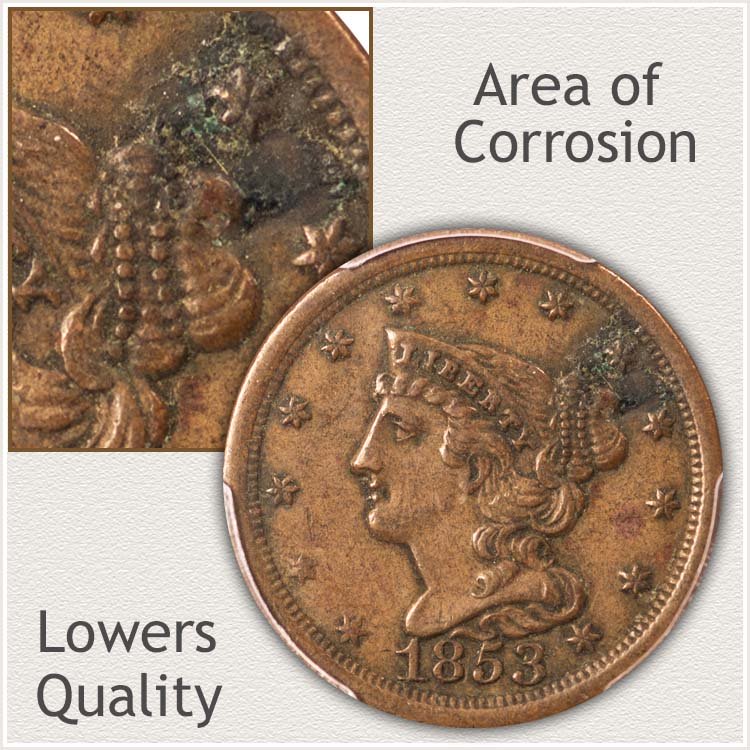
On this 1853 half cent, corrosion has taken hold, darkening and pitting the surface.
A half cent, no matter the grade, if pleasing to the eye is a special coin. These coins are scarce and undamaged pieces are highly valued by collectors.
References
US Mint. 1937 US Mint Report.
https://nnp.wustl.edu/library/book/514141
US Mint. 1948 US Mint Annual Report.
https://nnp.wustl.edu/library/publisherdetail/51
Coin Values | CoinStudy Articles
Seven and three quarter million half cents where minted from 1793 until 1857 when the denomination was discounted. It is remarkable a coin minted so long ago survives to this day. It is even more remarkable some of these coins are still in mint state condition. All half cents are an important part of our history.
Penny Values | Rare Pennies Have Outstanding Values
Discover the value of all your pennies. From the rare and valuable Large Cents to the popular Indian cent. Next check your wheat pennies, especially the early years. Match your coins to images identifying correct series. Follow a step by step process to find an accurate value on charts. Some of these old pennies have amazing values.
An excellent picture index of all major US coin series. Compare and identify your coin to the picture, click on the image, and go immediately to your old coin value.
Coin Value Guide | How to Value a Coin Collection
A step by step method combined with the coin value online guide identifies how to value a coin collection. Discover how much your box of old coins is worth.
Introduction into the selling coins process. Preparing, organizing, and planning all combine to improve results.
Old US Penny Values are Rising
Coin values are determined by using the grading images to judge condition then checking the date and values on the charts provided. Discover all the rare varieties, dates and mintmarks.
★ Coin Values Discovery finds Half Cent Values and...
All old US coin values. It is an excellent index with images and text links to all coin series, from Cents to Gold. Value charts, grading images and descriptions uncover how much your box of old coins is worth.